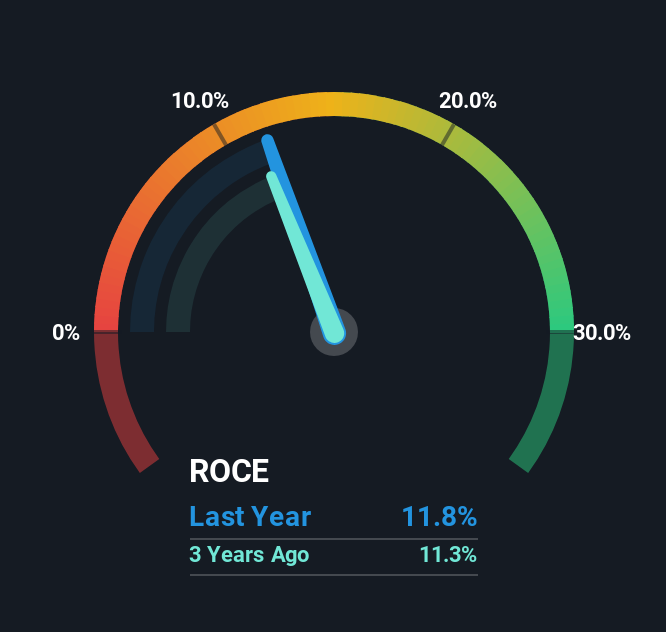- Greece
- /
- Oil and Gas
- /
- ATSE:ELIN
Investors Met With Slowing Returns on Capital At Elinoil Hellenic Petroleum (ATH:ELIN)
If we want to find a stock that could multiply over the long term, what are the underlying trends we should look for? In a perfect world, we'd like to see a company investing more capital into its business and ideally the returns earned from that capital are also increasing. Basically this means that a company has profitable initiatives that it can continue to reinvest in, which is a trait of a compounding machine. With that in mind, the ROCE of Elinoil Hellenic Petroleum (ATH:ELIN) looks decent, right now, so lets see what the trend of returns can tell us.
What Is Return On Capital Employed (ROCE)?
For those that aren't sure what ROCE is, it measures the amount of pre-tax profits a company can generate from the capital employed in its business. To calculate this metric for Elinoil Hellenic Petroleum, this is the formula:
Return on Capital Employed = Earnings Before Interest and Tax (EBIT) ÷ (Total Assets - Current Liabilities)
0.12 = €15m ÷ (€262m - €135m) (Based on the trailing twelve months to June 2025).
Thus, Elinoil Hellenic Petroleum has an ROCE of 12%. On its own, that's a standard return, however it's much better than the 8.3% generated by the Oil and Gas industry.
Check out our latest analysis for Elinoil Hellenic Petroleum

Historical performance is a great place to start when researching a stock so above you can see the gauge for Elinoil Hellenic Petroleum's ROCE against it's prior returns. If you'd like to look at how Elinoil Hellenic Petroleum has performed in the past in other metrics, you can view this free graph of Elinoil Hellenic Petroleum's past earnings, revenue and cash flow.
The Trend Of ROCE
The trend of ROCE doesn't stand out much, but returns on a whole are decent. Over the past five years, ROCE has remained relatively flat at around 12% and the business has deployed 97% more capital into its operations. 12% is a pretty standard return, and it provides some comfort knowing that Elinoil Hellenic Petroleum has consistently earned this amount. Over long periods of time, returns like these might not be too exciting, but with consistency they can pay off in terms of share price returns.
One more thing to note, even though ROCE has remained relatively flat over the last five years, the reduction in current liabilities to 52% of total assets, is good to see from a business owner's perspective. This can eliminate some of the risks inherent in the operations because the business has less outstanding obligations to their suppliers and or short-term creditors than they did previously. Although because current liabilities are still 52%, some of that risk is still prevalent.
Our Take On Elinoil Hellenic Petroleum's ROCE
The main thing to remember is that Elinoil Hellenic Petroleum has proven its ability to continually reinvest at respectable rates of return. And long term investors would be thrilled with the 119% return they've received over the last five years. So while the positive underlying trends may be accounted for by investors, we still think this stock is worth looking into further.
Elinoil Hellenic Petroleum does have some risks, we noticed 3 warning signs (and 1 which makes us a bit uncomfortable) we think you should know about.
While Elinoil Hellenic Petroleum may not currently earn the highest returns, we've compiled a list of companies that currently earn more than 25% return on equity. Check out this free list here.
Valuation is complex, but we're here to simplify it.
Discover if Elinoil Hellenic Petroleum might be undervalued or overvalued with our detailed analysis, featuring fair value estimates, potential risks, dividends, insider trades, and its financial condition.
Access Free AnalysisHave feedback on this article? Concerned about the content? Get in touch with us directly. Alternatively, email editorial-team (at) simplywallst.com.
This article by Simply Wall St is general in nature. We provide commentary based on historical data and analyst forecasts only using an unbiased methodology and our articles are not intended to be financial advice. It does not constitute a recommendation to buy or sell any stock, and does not take account of your objectives, or your financial situation. We aim to bring you long-term focused analysis driven by fundamental data. Note that our analysis may not factor in the latest price-sensitive company announcements or qualitative material. Simply Wall St has no position in any stocks mentioned.
About ATSE:ELIN
Elinoil Hellenic Petroleum
Engages in trading of liquid and solid fuels, and lubricants.
Solid track record, good value and pays a dividend.
Market Insights
Community Narratives



